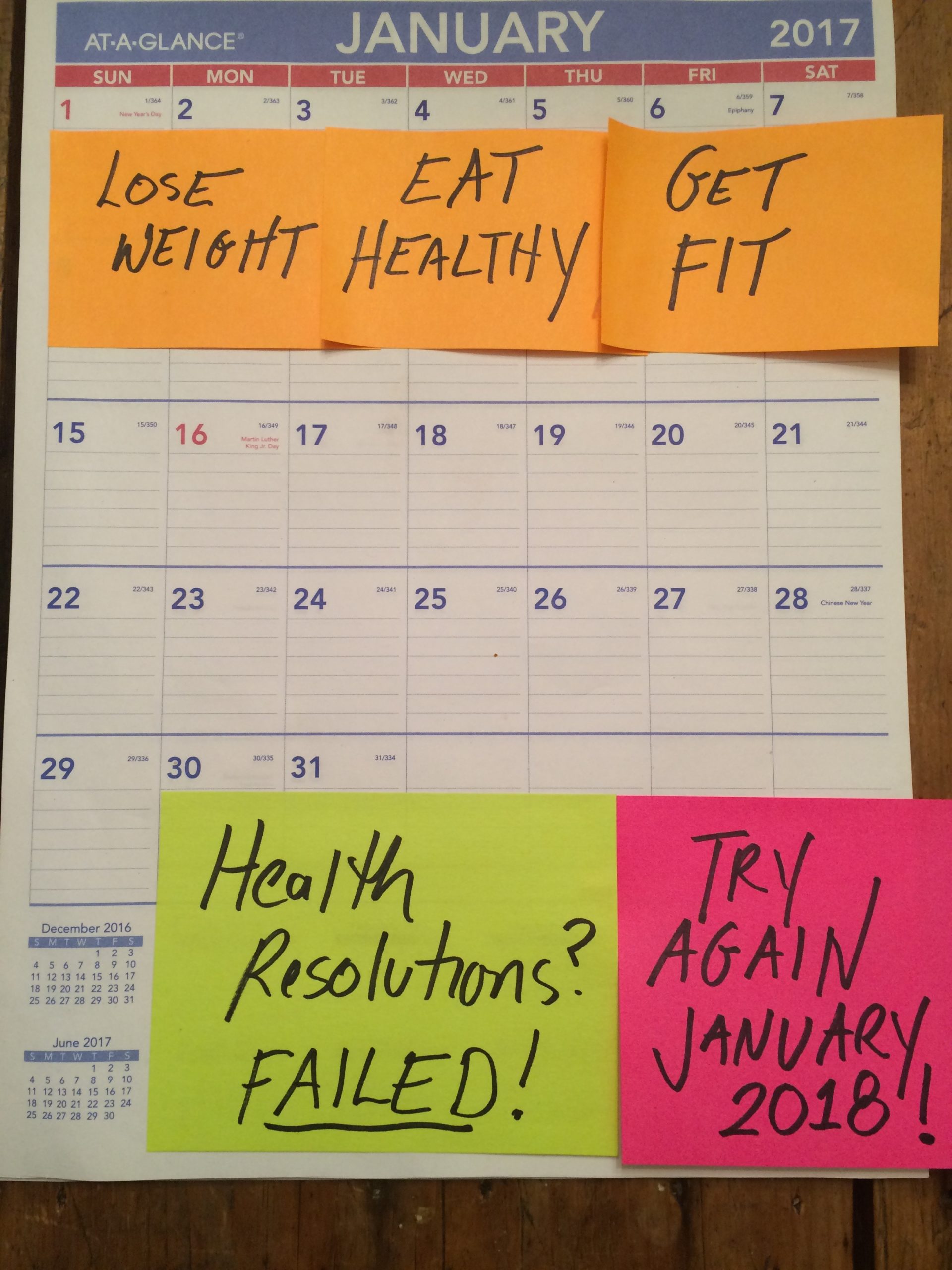Did you make a New Year’s health resolution—like losing weight, getting fit, or eating healthy? In all likelihood, by end-January, that initial fire in your belly has faded. Maybe you’ve even reverted to familiar (but unhealthy) habits.
An estimated 92% of people fail to keep their New Year’s resolutions, according to a University of Scranton study.
Every year, people tend to make the same resolutions (often health-related), vowing on average 10 times to change a potentially harmful behavior. This cycle of resolving to change—trying but not succeeding—is what social researchers call False Hope Syndrome; it is especially common among people trying to lose weight.
The bottom line: improving your health requires a commitment—to yourself. This means openness to new ideas and approaches to reach your goal. Evolving a 2.0 version of yourself also means being willing to invest time, money and energy in getting the expert support, education, guidance and accountability you need, whether it’s a personal trainer, yoga classes, a certified nutrition health coach (like myself!), cooking lessons, or a chiropractor.
The keys to success? Having a plan. Setting specific, attainable goals. Measuring your progress. Enlisting expert support. Taking small steps. So…rather than resolving to “lose 50 pounds by April” on Jan. 1st—an unrealistic aspiration under most circumstances—set smaller, achievable goals. Make healthy shifts (see below), which help create a foundation of healthy behaviors upon which you can build.
1. Drink enough quality water
Dehydration can masquerade as headaches, dizziness, irritability, fatigue, inability to concentrate, bad breath, constipation, muscle cramps—even sugar cravings. Drinking enough quality (i.e. filtered) water supports your metabolism, elimination and detoxification. Aim to drink half your body weight in ounces of water. Check the color of your pee: if it’s pale yellow or nearly clear, you’re hydrated.
2. Eat dark, leafy greens
Compared to tomatoes, potatoes and corn, Americans eat an underwhelming amount of dark, leafy greens, like kale, collards, spinach, mustard greens, and Swiss chard. Leafy greens are low-calorie, high fiber and, rich in vitamins (A, C, E, K) and minerals, such as calcium, magnesium, iron, potassium, phosphorus and zinc. Eating 8+ servings of leafy greens daily boosts immunity, promotes detoxification, lowers cholesterol, improves gut flora (and overall digestive health) and can help protect the brain from Alzheimer’s and dementia. Start with 1 to 2 servings of leafy greens at every meal: add greens to a smoothie or eggs at breakfast; have broccoli soup or a large mixed green salad at lunch; and eat a generous side of braised kale at dinner. Ideally, you’ll work your way up to 8+ servings of leafy greens.
3. Eat a protein-rich breakfast
Your first meal of the day, whether it’s at 6:00am or 10:30am, sets the metabolic tone for your day. If you skip breakfast entirely, you’ll likely overeat later in the day. If you eat a high sugar breakfast, like coffee with toast, cereal, bagels or pastries, you’re setting yourself up for an all-day blood sugar rollercoaster of constant hunger, low energy and cravings. Instead, prioritize eating a breakfast consisting of quality protein + fiber + healthy fat. Try a green smoothie with blueberries, flaxseed and protein powder or a three-egg (including yolks) spinach and mushroom omelet, topped with avocado slices.
4. Wean off of sugar and artificial sweeteners
The average American consumes 150 to 170 pounds of sugar a year, or, 1/4 to 1/2 pound of sugar daily. For perspective, the average colonist in the early 1700s ate approximately 4 pounds of sugar a year! Most of the sugar consumed today lurks in our food—from pizza, sandwiches and salad dressings, to fast food, takeout and beverages. Soda is liquid sugar: drinking four 12-ounce cans of soda is the equivalent of downing 1/4 pound of sugar. While artificial sweeteners, like Splenda, aspartame and saccharin are technically “calorie free”, they can confuse your body into storing fat, trigger sugar cravings and contribute to insulin resistance, making it harder to lose weight. Aim to reduce your intake of obvious and hidden sources of sugar. At the same time, retrain your tastebuds to appreciate naturally sweet-tasting foods, like roasted vegetables—winter squashes (butternut, kabocha squash fries or roasted delicata), beets, parsnips, sweet potatoes and caramelized onions.
5. Take a whole foods approach to detoxifying
The liver is a vital organ that filters out toxins from the body. Linked to obesity, diabetes, heart disease, depression and cancer, sugar has been labeled a toxin that places a tremendous burden on the liver. So, too, does our daily exposure to 80,000-plus chemicals in the U.S., many of which have never been fully tested for their adverse effects on our health and environment. Doing a seasonal, whole foods cleanse, like my 7-Day Body Reset Cleanse, gives the liver a much-needed break—much like hitting a “reset” button for the body. Yes, you will be eating real food, but eliminating sugar, caffeine, alcohol, processed foods and common allergenic foods.
6. Start cooking
In my former life, I ate most of my meals out; here’s why I prefer preparing my own meals now. Cooking in your kitchen is one of the most powerful ways to transform your health. You have control over the quality (and amount) of ingredients that go into your meal—and what stays out (sugar, excessive salt, unhealthy fats, like highly refined canola and soybean oils, additives, preservatives, food coloring, GMO ingredients). The good news? Cooking does not have to be complicated or time-consuming, nor do you have to be five-star chef. Simple is best. If you lack confidence in the kitchen, practice making a few basic meals that you enjoy: scrambled eggs, a yummy smoothie or buckwheat pancakes. If you’re time-challenged, choose one day, like a Saturday or Sunday, when you can bulk-cook for yourself and/or your family. One pot dishes, like a grass-fed sloppy joe meat sauce, coconut milk-braised ground lamb and zucchini and vegetable and grass-fed ground beef ragu can be made in advance and rewarmed.
7. Get support
We don’t know what we don’t know. And we can have blind spots when it comes to what we do know. For example, if repeated efforts to lose weight by eating a low-calorie diet have been unsuccessful, then your unshakeable belief that “calories in, calories out equals weight loss”—even though it’s never worked for you—is your blind spot. You may have a hormonal imbalance, food sensitivity or other stressors causing weight gain. Unless you enlist support—an integrative nutrition health coach, like me, who focuses on digestive and hormone health; a functional medicine doctor; a naturopath; or any other integrative practitioner—you’ll be stuck in a cycle of doing the same thing, yet expecting different results each time.
8. Let go of toxic relationships
Studies show that being in a toxic relationship can wreak havoc on your health—as much as fast food or a toxic environment! A toxic relationship—one where you are constantly criticized, demeaned, disrespected; treated with indifference or ingratitude; or you are the one who is always giving—can exist in any relationship, including your spouse/partner, friendships, parent/child relationship, siblings, or co-workers.
This type of relationship tends to make you feel drained and depleted. A Michigan State University study found a 34 percent increased risk of heart disease for people involved in a toxic relationship. Another study found that ongoing negative conflict in a relationship contributed to an earlier death (by 11 years). High-conflict marriages are associated with higher blood sugar levels, higher blood pressure and higher rates of obesity, as well as greater incidences of diabetes, heart attack and stroke. If you are in a toxic relationship, consider distancing yourself from the source of toxicity. And get support to help you engage in healthy relationships.
9. Move more
Research links excessive sitting with increased risk of cancer, heart disease, type 2 diabetes and a shorter life expectancy—even if you exercise regularly. Say, you exercise—engaging in physical activity that makes you sweat—the recommended 30 minutes a day (or more), then spend the rest of your day sitting. II’s analogous to taking a multivitamin, then eating junk food all day.
Simple changes can help you be mindful of moving more. Use a Fitbit, pedometer, or your phone to track daily steps (aim for 10,000). Set a timer to go off every hour and walk around the office. Schedule a walking meeting. Pace during a conference call. Walk while talking on the phone. Take the stairs whenever possible. Go out and pick up your food instead of having it delivered. And park on the outskirts of the parking lot.
10. Change your mindset
We are a culture conditioned to expect instant gratification. Transforming your heath is an ongoing journey—not a day trip. Before you can achieve your health goals, you need to have the right mindset. 1) Start with small, achievable goals to build your “success” muscle. For example, commit to taking the stairs when you arrive and leave your office every day, or have a smoothie with 1 cup of greens every morning. 2) Be patient! Even when you’re doing everything “right”, progress is neither linear nor predictable. Making lasting changes takes time. 3) Doing something towards your goal—no matter how small—is always better than doing nothing. If you don’t have an hour to work out at the gym, use the 15 free minutes you do have for a high-intensity bodyweight workout. 4) Get back on the horse. Don’t use a temporary slip-up as an excuse to quit. If meeting friends after work turns into a mega wine-pizza-dessert fest, start fresh at the next meal—don’t wait until January 1st to get back on a healthy eating track! Resilience is key to long-term success.


